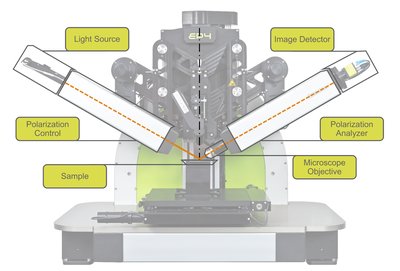The basic geometry resembles the typical setup of any ellipsometer: A light source and polarization control are mounted on one “arm” of the instrument, providing a light beam that illuminates the sample at an oblique angle of incidence (AOI). The probing beam reflects from or transmits through the sample and is collected by another “arm” for polarization analysis and intensity detection. Both “arms” are mounted onto a mechanical high-precision goniometer to probe the sample at different AOIs.
The distinct feature of an Imaging Ellipsometer is the use of imaging components in the detection “arm” (Fig.1). A microscope objective, located between the sample and the polarization analyzer, creates a magnified image of the illuminated sample surface on a digital image detector (CCD of CMOS camera). This camera does not only serve for supervision of the probed sample spot (as it might do in regular ellipsometers), but the camera pixels itself are the photo detectors that are used for the ellipsometric measurement.













